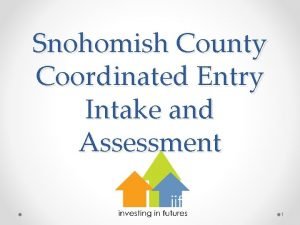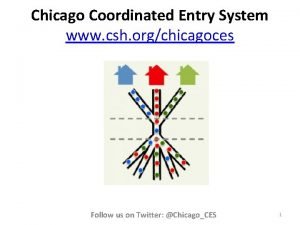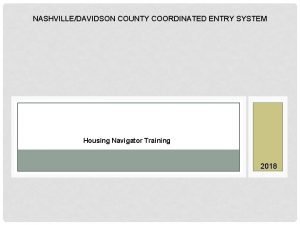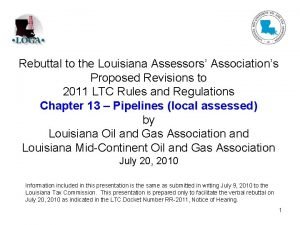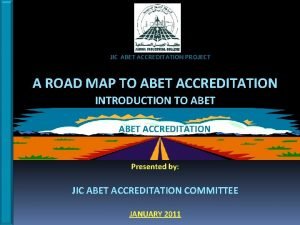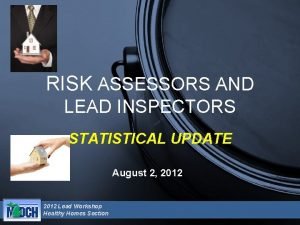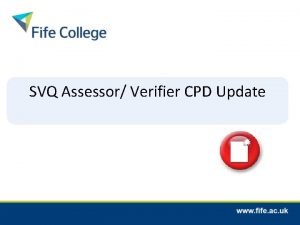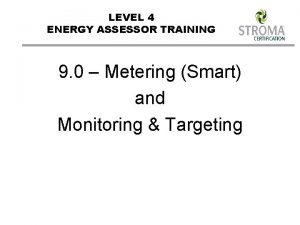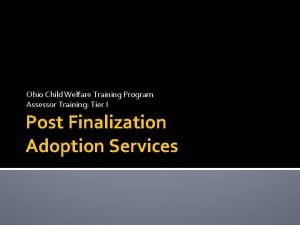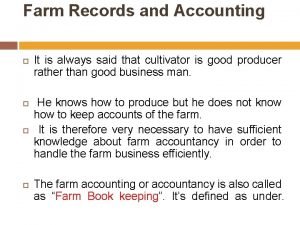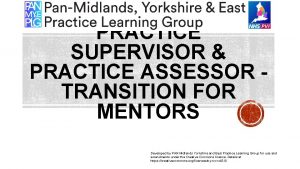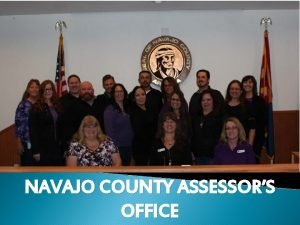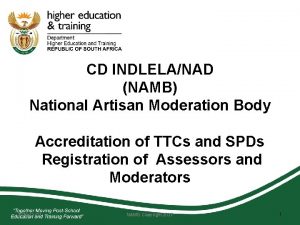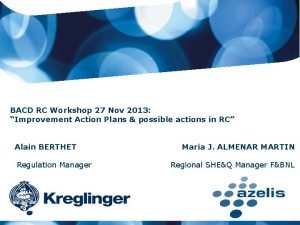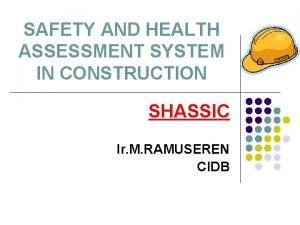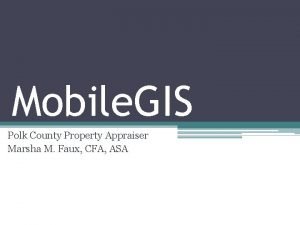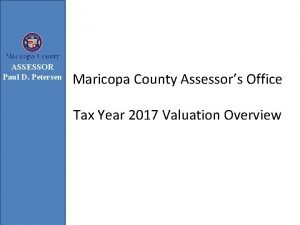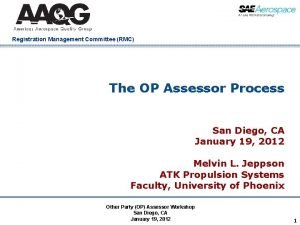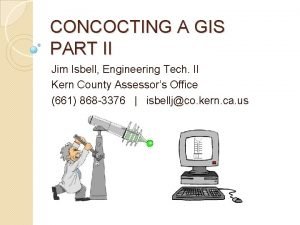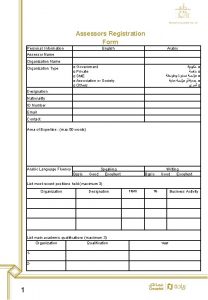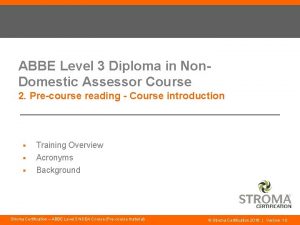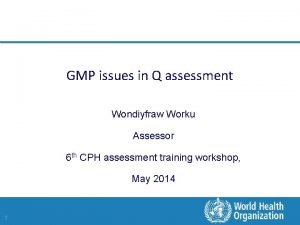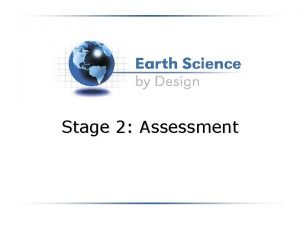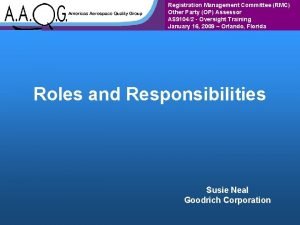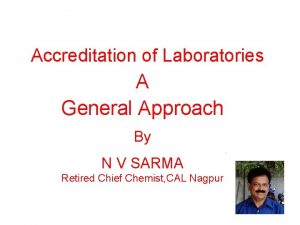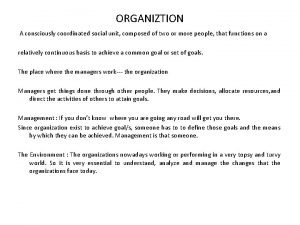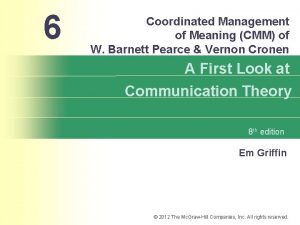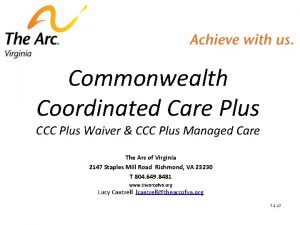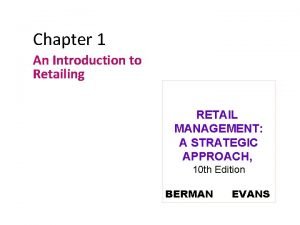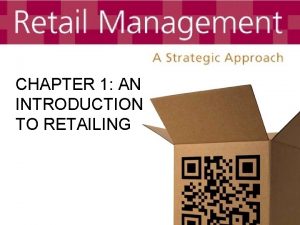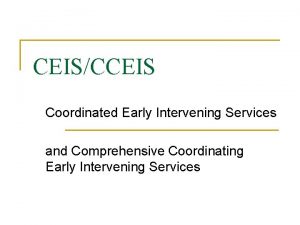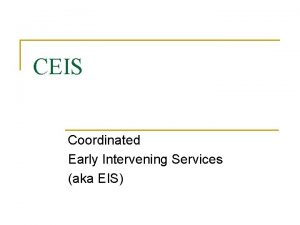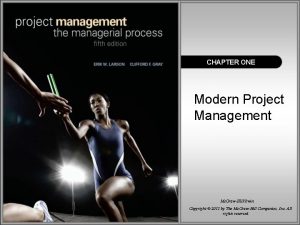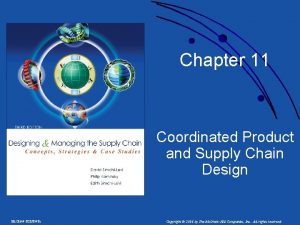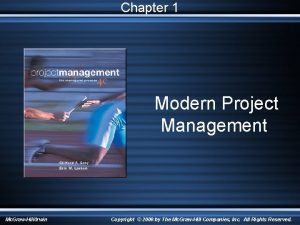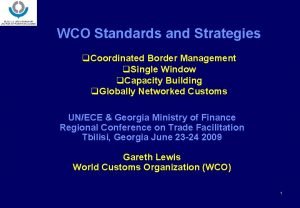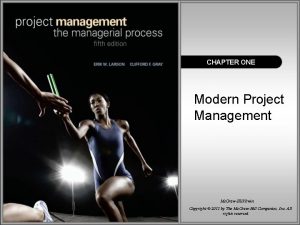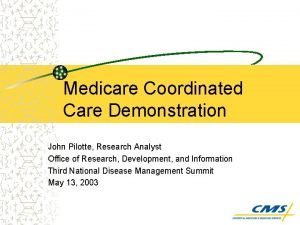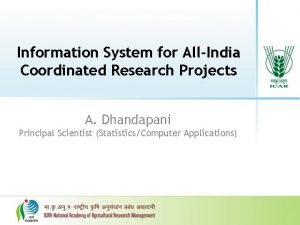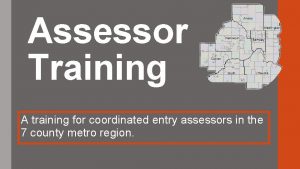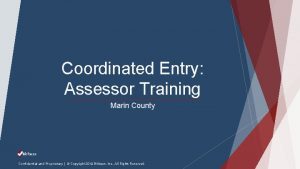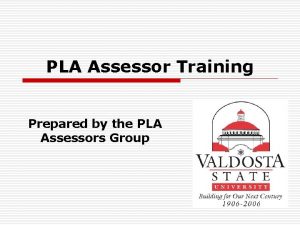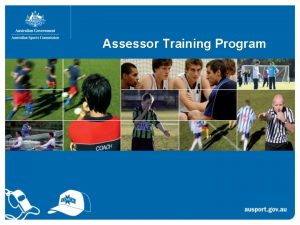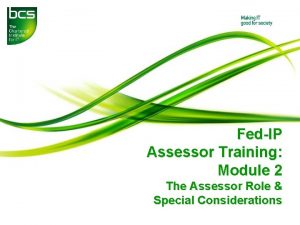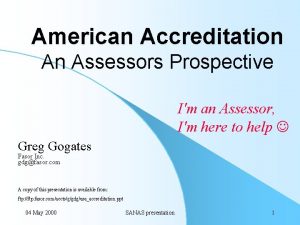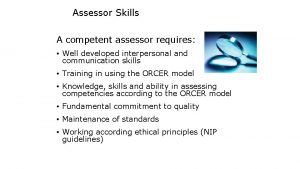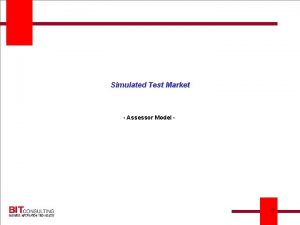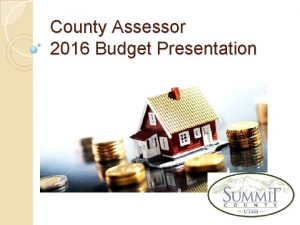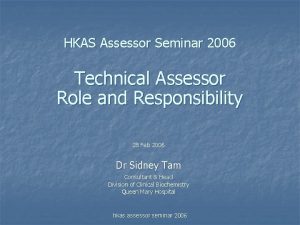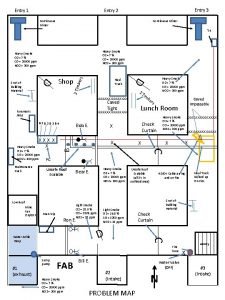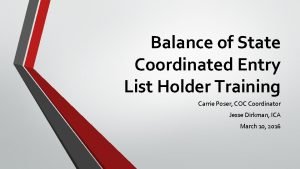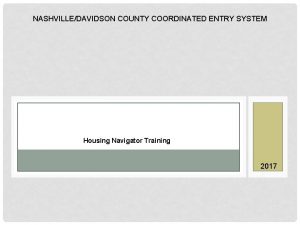Assessor Training A training for coordinated entry assessors


















































































- Slides: 82

Assessor Training A training for coordinated entry assessors in the 7 county metro region.

So this training makes me an assessor? ……. nope. Contact your COC point person to sign up to be an assessor: Hennepin: CES. hennepin@hennepin. us Ramsey: Heather Clemen: heather. clemen@co. ramsey. mn. us SMAC: Abby Guilford, abby@mesh-mn. org

Goals & Learning Objectives • By completing this course, you will understand: Origin of Coordinated Entry Roles of the various stakeholders throughout the Coordinated Entry System (CES) Overarching principles that drive the CES process Components of CES overall Components of the assessment process How to complete an accurate, nuanced assessment • GOALS: A more complete understanding of the Coordinated Entry System Explore how you can add value to the process and make it stronger

Coordinated Entry System Overview

Coordinated Entry is a Work in Progress • Create a client-centered system by simplifying and streamlining access to assistance • Reduce the length of time spent homeless • Provide connection (with the most appropriate level of assistance needed) to transition from homelessness to stable housing • More accountability in the system • Allocating resources based on need • Ability to easily identify gaps in resources or clientele.

Role of the Assessor • Conduct assessment and gather the information that will determine what kind of assistance a client will receive, or whether they will qualify for assistance in the first place.

Role of the Assessor • Conduct assessment and gather the information that will determine what kind of assistance a client will receive, or whether they will qualify for assistance in the first place. • Act as the face of Coordinated Entry for the client

Role of the Assessor • Conduct assessment and gather the information that will determine what kind of assistance a client will receive, or whether they will qualify for assistance in the first place. • Act as the face of Coordinated Entry for the client • Assessors are responsible for making assessments as culturally responsive and trauma informed as possible.

Role of the Assessor • Conduct assessment and gather the information that will determine what kind of assistance a client will receive, or whether they will qualify for assistance in the first place. • Act as the face of Coordinated Entry for the client • Assessors are responsible for making assessments as culturally responsive and trauma informed as possible. • Answer questions • Housing is not guaranteed nor immediate

Describing Coordinated Entry Create a 30 second speech summarizing the basic process of Coordinated Entry. Here are some talking points to include: • Housing is not immediate or guaranteed • Coordinated Entry connects you to subsidized housing • The assessment process is invasive and includes many personal questions • The wait time may be long, please continue to work on other housing options • Describe the importance of staying in contact with assessor and providing updates.

Components of CES • Access • Assessment • Prioritization • Referral

Access • This is quite different for each region (Hennepin, Ramsey, SMAC) and population. • Shelters, outreach workers, assessment phone lines • Screening tools, marketing, educating partners and the community

Access www. safehomemn. org www. headinghomeramsey. org www. hennepin. us/coordinated-entry www. smacmn. org

Access

Access Eligibility – Who do I assess? Proof of residency? Single Family Not required MN Homeless HUD Homeless Federal definitions of homeless youth (RHY, Mc. Kinney-Vento, HEARTH) HUD LTH Chronic Required PNMHH** or Emergency shelter PNMHH or Emergency shelter SMAC Ramsey* Hennepin Youth *Ramsey eligibility is pending approval **PNMHH – Place Not Meant for Human Habitation

Assessment Will come back to this because it’s the bulk of this training!!

PSH Prioritization Hennepin Ramsey SMAC Disabling Condition HUD Chronic MN LTH VI-SPDAT score Homeless Status HUD Months Homeless MN Months Homeless VI-SPDAT Score Months HUD VI-SPDAT Score Homeless Transitional Housing HUD Months Homeless MN LTH definition

“Where am I on the list? ”

Priority List Example

Referral • Housing programs submit their openings to Priority List Manager • List is further sorted/filtered based on eligibility criteria of specific openings • Housing is not guaranteed nor immediate

Conducting a CE Assessment Release of information, Supplemental questions, SPDAT

Best Assessment Practices • Client Centered • Culturally • Trauma Responsive Informed

The Three Parts of the Assessment • Releases • Supplemental Questions • VI-SPDAT • www. safehomemn. org

Releases and Confidentiality

Describing Releases of Information • Not everyone reads everything they commit their signature to it. • Get to know your needed releases of information so that you can summarize what they are and why they are needed to your clients so they make an informed decision about what they are signing and disclosing. For example: The Tennessen Notice – Let your client know that they are signing a privacy and confidentiality notice. That the document states they are not legally bound to answer your questions. However, let them know that you are a mandated reporter and that some of their answers may require you to act as such.


SMAC Case Consultation • SMAC will be using case consultation as part of the prioritization and referral process. • In order to facilitate this case consultation, clients, both new and previously assessed, will need to sign a case consultation release and upload it to the clients’ HMIS file. • (the new case consultation release is available on the www. safehomemn. com website)

What if they don’t share? • NEED some sort of release to release the assessment to the Priority List Manager • Process is different – more complicated for the client

Don’t Put Them in HMIS • Domestic Violence and Sexually Exploited Youth (SEY) – safety planning and connect to resources Domestic Violence: dayoneservices. org/ List of Regional Navigators for SEY: www. health. state. mn. us/injury/topic/safeharbor/navigators. html • Minor youth (16 -17) year olds – No HMIS!

Every Veteran can join the Registry! • Every Veteran can Join the Registry by calling 1 -888 -Link. Vet (888 -5465838) or by completing the Registry application on MDVA’s website: https: //mn. gov/mdva/resources/homelessnessandprevention/homelessv eteranregistry. jsp • When in doubt, fill it out! If you don’t know if someone is a Veteran or not, have them complete the Registry application/documents, and we can determine their status. • With any other questions, providers can contact the Homeless Veteran Coordinator directly…

Contact Information: Paul Williams, MPA, Homeless Programs Coordinator Minnesota Department of Veterans Affairs Direct 651 -201 -8230 | Fax 651 -797 -1782 20 West 12 th Street, 2 nd Floor | St. Paul, MN 55155 Have veteran related questions? Call 1 -888 -Link. Vet (1 -888 -546 -5838) www. minnesotaveteran. org or www. mn. gov/mdva

Supplemental Questions

Supplemental Questions • Questions that housing programs need to know to determine if a person is eligible for their program. • This section should conversational – get to know the client, understand their needs. • SMAC: Step 1 and 2


Being trauma informed in the supplemental questions Asking about • Sexual Exploitation • Domestic Violence. • Mental Health • Chemical Dependency • Some advice… • Be empathetic • Thank the client for sharing their experience with you • Openly acknowledge how difficult and retraumatizing it can be to talk about their experience • Be ready to support this person with relevant resources in the community


You are one of their contacts. • Remind the client that the assessor is usually one of the people contacted when housing providers are trying to track clients down.

Be Creative Social Media accounts (use private messages, consider confidentiality) Relatives, even ones with whom they don’t get along Hang out spots Other agencies they use

Preferences and needs

Is My Client Homeless? Chronic and Long-Term Homeless Definitions Adapted from: Homelessness 201 June 14, 2017 Heather Duchscherer, Hearth Connection Marti Maltby, Common. Bond

Housing History

Where We’re Going HUD Homeless Chronic Homeless Definition MN Homeless Long-Term Homeless Definition Documenting Homelessness

HUD Homeless For assessment purposes – Sleeping in a place not meant for human habitation – Staying in emergency shelter, or hotel/motel paid for by government or charitable organization – Exiting an institution (e. g. jail, hospital) where they resided for 90 days or fewer and were residing in emergency shelter or place not meant for human habitation immediately before entering institution – Fleeing/attempting to flee domestic violence https: //www. hudexchange. info/resources/documents/Homeless. Definition_Recordkeeping. Requirementsand. Criteria. pdf

HUD Chronic Homelessness An individual who: – Is HUD Homeless; and – Has been HUD homeless continuously for at least one year or on at least four separate occasions in the last 3 years where the combined occasions total a length of time of at least 12 months. Each period separating the occasions must include at least 7 nights of living in a situation other than a place not meant for human habitation or in an emergency shelter; and https: //www. hudexchange. info/resources/documents/Homeless. Definition_Recordkeeping. Requirementsand. Criteria. pdf

HUD Chronic Homelessness – Has a disabling condition: substance use disorder, serious mental illness, developmental disability, post-traumatic stress disorder, cognitive impairments resulting from brain injury, or chronic physical illness or disability; An individual who has been in an institution (e. g. jail, treatment, hospital) for fewer than 90 days and meets the criteria in the first paragraph; or For a FAMILY to be considered Chronic, only one head of household needs to meet this definition https: //www. hudexchange. info/resources/documents/Homeless. Definition_Recordkeeping. Requirementsand. Criteria. pdf

https: //www. hudexchange. info/resources/documents/Flowchart-of-HUDs. Definition-of-Chronic-Homelessness. pdf SAFE HOME WEBSITE

MN Homeless Definitions : Homeless (Minnesota): All HUD definitions, PLUS “doubled up. ” Doubled up/couch hopping: A household is doubled up with another household (and duration is less than one year) or couch hops as a temporary way to avoid living on the streets or an emergency shelter.

Long-Term Homeless (LTH) Definition: Households who are MN Homeless continuously for a year or more or at least four times in the past three years. Note: Minnesota's definition does not require that the person have a disabling condition.

LTH sticky point: Neutral (Institutional): Time spent in an institution (jail, treatment, hospital, etc. ) IS counted as homeless for the first 90 days (like HUD) if the person was MN homeless before they went in. Time spent in an institution is NOT counted if the stay is 91 days or longer – it is considered “neutral. ”

Counting months and episodes of homelessness • 11/2015 -Present – Couch hopping with different people in Dakota – each place 2 weeks to 6 months • 7/2015 – 11/2015 Renting in Apple Valley

Counting months and episodes of homelessness • 7/15/18 -7/31/18 – Couch-hopping in Dakota • 4/1/18/7/15/18 – Staying with Mom in Ramsey • January 2018 -March 2018 – Matrix shelter in Dakota • 11/2015 -2/2017 – Couch hopping with different people in Dakota • 7/2015 – 11/2015 Renting in Apple Valley

Counting months and episodes of homelessness • 7/15/18 -7/31/18 – Couch-hopping in Dakota • 4/1/18/7/15/18 – Couch hopping with Mom in Ramsey • January 2018 -March 2018 – Matrix shelter in Dakota • October 2017 -December 2017 – Jail in Dakota County • 11/2015 -10/2017 – Couch hopping with different people in Dakota • 7/2015 – 11/2015 Renting in Apple Valley

Exercise: Scenario 1 • 7/15/18 -7/31/18 – Couch-hopping in Dakota • 4/1/18/7/15/18 – Couch hopping with Mom in Ramsey • January 2018 -March 2018 – Matrix shelter in Dakota • October 2017 -December 2017 – Jail in Dakota County • August 2017 – October 2017 – Couch-hopping in Dakota Co. • April 2017 -July 2017 – Higher Ground Shelter Mpls • 2/1/17 -4/1/17 – Treatment • January 2017 -2/1/17 – Higher Ground Shelter Mpls • 11/2015 -Dec. 31 st 2016 - Couch hopping with different people in Dakota • 7/2015 – 11/2015 Renting in Apple Valley

Scenario 2 • 7/15/18 -7/31/18 – Couch-hopping in Dakota • 4/1/18/7/15/18 – Couch hopping with Mom in Ramsey • January 2018 -March 2018 – Matrix shelter in Dakota • October 2017 -December 2017 – Jail in Dakota County • August 2017 – October 2017 – Couch-hopping in Dakota Co. • April 2017 -July 2017 – Higher Ground Shelter Mpls • 2/1/17 -4/1/17 – Treatment • January 2017 -2/1/17 – Higher Ground Shelter Mpls • 11/2015 -Dec. 31 st 2016 – Staying with sister • 7/2015 – 11/2015 Renting in Apple Valley

Scenario 3 • 7/15/18 -Present – Couch-hopping in Dakota • 4/1/18/7/15/18 – Couch hopping with Mom in Ramsey • January 2018 -March 2018 – Matrix shelter in Dakota • October 2017 -December 2017 – Jail in Dakota County • August 2017 – October 2017 – Couch-hopping in Dakota Co. • April 2017 -July 2017 – Higher Ground Shelter Mpls • 2/1/17 -4/1/17 – Treatment • January 2017 -2/1/17 – Higher Ground Shelter Mpls • 11/2016 -Dec. 31 st 2016 – Living at Lincoln Place, Dakota Co. – kicked out • 11/2015 -11/2016 – Going between car and mom’s – staying 1 or 2 nights per week in car • 7/2015 – 11/2015 Renting in Apple Valley

Scenario 4 MN Homelessness: Episodes: 1 Months: 29 ½ LTH: Yes HUD Homelessness: Episodes: 2 Months: 10 Chronic: No

Housing History in HMIS

Housing History in HMIS How long was that episode? Within the past 6 nights, were they HUD homeless? Number of HUD homeless episodes Where did they sleep last night?

Housing History Practice • Work with the people around you to discern fictional homeless histories

“My client doesn’t know exact dates” • Acknowledge this is difficult for lots of folks, and it can be retraumatizing. • Ultimately, we need to make a case for one of the definitions, so it’s our job to be sure we get enough information to get the client a referral. • Strategies: Have the client write it down outside of assessment time Ask about seasons, holidays to narrow down periods of time When clients say “I was couch-hopping or outside for 2 years, ” ask if they can estimate percentages of time, total number of months spent outside, how many days they would couch-hop in between. Sports, current events. Looking at cell phone text history if they were couch hopping Others?

Additional Notes Section • • Elaborate housing history and housing status • Explain household composition • Note chronic illness, explain medical situation • If client is pregnant, indicate due date • If a person’s housing, legal or family history is confusing, explain it here. If a client has copies of their ID’s and any additional documentation, make a copy of it, then upload to HMIS if possible.

The VI-SPDAT Vulnerability Index - Service Prioritization Decision Assistance Tool “The SPDAT is an evidence-informed approach to assessing an individual’s or family’s acuity. ”

The VI-SPDAT Single VI-SPDAT Family TAY-VI-SPDAT (transitioned aged youth 16 -24)

The SPDAT (Single Adult VI-SPDAT training video) http: //vimeo. com/86520820

The VI-SPDAT • Ask questions as they are written • Answer clients’ questions • Ask questions for verification • No coaching

The VI-SPDAT Script • The Tribal Collaborative, MESH and members of COC’s across the state worked to change the VI-SPDAT script to reflect a more culturally responsive approach to these questions. • COC’s are required to use these new scripts starting OCT 1.

VI-SPDAT Question Example


Scoring Summary

Housing within CE Time Limited Non. Time Limited • Transitional Housing (TLP)– MN and Federally funded – Site Based, time limited housing and supports with 6 months of follow support services • Rapid Re-Housing (RRH)– Scattered Site. Designed to quickly exit households from homelessness into permanent housing (housing first). Ranges from a couple months to 2 years. • Permanent Supportive Housing (PSH) – Non-time limited affordable housing assistance with wrap-around supportive services for people experiencing homelessness and have a disability. • Housing Support Services (formally GRH) – (MN) - housing support services, a person must have county approval for residence in an approved setting and must: (1) be aged, blind, or over 18 years old and disabled, and meet specified income and asset standards; or (2) belong to a category of individuals potentially eligible for General Assistance and meet specified income and asset standards. 70

Process for referral • You completed the VI-SPDAT and Supplemental Questions – Now What? • With a few exceptions, all assessment information needs to be uploaded to HMIS. Some exceptions include minors, domestic violence survivors • Ask within your agency who is responsible for data entry

Upload documents in HMIS! Scroll down

What comes next? Having a good closing conversation with your client helps prepare them for their next steps

How to end your meeting How you end the meeting with your client will prepare them for what to do next. Here are some closing conversation pointers to include in your wrap up. • What did they score? Describe what this type of housing is • Are they move-in ready? Talk about what documentation they may need. • Are they currently in need of shelter or assistance? Connect them with resources. • Describe the importance of keeping you updated on their information • Explain the importance of continuing to work on additional housing solutions • Thank your client for sharing their life and their experience with you. Acknowledge the difficulty and the invasive nature of the assessment.

Having difficult conversations…. • If they score a 3 or lower, they are not eligible for Coordinated Entry and you need to tell them. • Even if someone scores for housing, they may still have a long wait. A way to make this easier…. Build up your housing alternatives to Coordinated Entry so you can help collaborate on next steps your client can work on

Obtaining Documentation • • After the assessment is complete, one of the most helpful things an assessor can do is help the client obtain documentation. Types of documentation that make the transition to housing efficient • • • State ID Birth Certificate(s) Social Security Cards Verifications (disability, homelessness) Documentation tips • Request documents from your county’s financial assistance or human services office • If the client has had a case open with the county they will likely have some documentation on file • Upload documents to HMIS (best option but only use when HIPPA compliant) • Store in your organizations database (make a note in HMIS)

UPDATES • Updates are important Tell the client: The best thing for someone who has been assessed to do is to keep in touch with the provide / assessor that originally conducted your assessment. If your contact information changes, or something significant about your circumstances changes (health, income, or entering mental health or treatment center), notify the person who assessed you and they can make sure your information is updated. You can input the updates yourself, or email the Priority List Manager and ask them to add the updates for you.

Updates in HMIS

UPDATES in SMAC Clients can do their own updates on the SMAC website: http: //smacmn. org/help/

So now you’re an assessor…. …. nope. Contact your COC point person to sign up to be an assessor: Hennepin: CES. hennepin@hennepin. us Ramsey: Clemen, Heather heather. clemen@co. ramsey. mn. us SMAC: Abby Guilford, abby@mesh-mn. org

Who is my Priority List Manager? • SMAC: Single and Family: Salvation Army – nor_smac_ces@usc. salvationarmy. org Youth: LSS Streetworks - coordinatedentry@lssmn. org • Ramsey: Single: Ramsey County - fas. coordinatedentry@co. ramsey. mn. us Family: Catholic Charities – CAHS@cctwincities. org Youth: LSS Streetworks – coordinatedentry@lssmn. org • Hennepin: Single, family, and youth: Hennepin County - CES. hennepin@hennepin. us

CE Data Entry http: //hmismn. org/coordinated-entry/
 Snohomish county coordinated entry
Snohomish county coordinated entry Chicago central referral system
Chicago central referral system Coordinated entry
Coordinated entry Housing navigator training
Housing navigator training Louisiana assessors association
Louisiana assessors association Jic map
Jic map Insurance loss assessor leicester
Insurance loss assessor leicester Fire risk assessors near me
Fire risk assessors near me L&d9di
L&d9di Domestic energy assessor course near me
Domestic energy assessor course near me Ohio child welfare training program
Ohio child welfare training program Ccrt
Ccrt Single entry system introduction
Single entry system introduction New entry exploitation
New entry exploitation Single entry system and double entry system
Single entry system and double entry system Aru mentorship
Aru mentorship Navajo county assessor
Navajo county assessor Chieta assessor registration
Chieta assessor registration Namb assessor registration
Namb assessor registration Auditor sqas assessor
Auditor sqas assessor Shassic
Shassic Practice assessor and practice supervisor
Practice assessor and practice supervisor Polk county nc gis
Polk county nc gis Maricopa county assessor
Maricopa county assessor Op assessor
Op assessor Lewis county assessor
Lewis county assessor Jim isbell
Jim isbell Assessor name
Assessor name Ndea course
Ndea course Rm assessor 3 ocr
Rm assessor 3 ocr Gmp assessor
Gmp assessor Thinking like an assessor
Thinking like an assessor Op assessor
Op assessor Purdue xerox
Purdue xerox Nabl 161
Nabl 161 Consciously coordinated
Consciously coordinated Coordinated management of meaning model
Coordinated management of meaning model Coordinated management of meaning theory examples
Coordinated management of meaning theory examples Ccc plus waiver
Ccc plus waiver Define retail management
Define retail management Coordinated effort in retailing concept
Coordinated effort in retailing concept Accelegrants
Accelegrants Coordinated early intervening services
Coordinated early intervening services A series of coordinated related multiple projects
A series of coordinated related multiple projects A series of coordinated related multiple projects
A series of coordinated related multiple projects Modern project management
Modern project management Coordinated product and supply chain design
Coordinated product and supply chain design Chapter 1 modern project management
Chapter 1 modern project management Wco building blocks
Wco building blocks A series of coordinated related multiple projects
A series of coordinated related multiple projects A series of coordinated related multiple projects
A series of coordinated related multiple projects Alabama coordinated health network
Alabama coordinated health network Medicare coordinated care demonstration
Medicare coordinated care demonstration All india coordinated research project
All india coordinated research project Coordinated plan on ai
Coordinated plan on ai Coordinated engagements
Coordinated engagements Fspos
Fspos Typiska drag för en novell
Typiska drag för en novell Tack för att ni lyssnade bild
Tack för att ni lyssnade bild Returpilarna
Returpilarna Shingelfrisyren
Shingelfrisyren En lathund för arbete med kontinuitetshantering
En lathund för arbete med kontinuitetshantering Adressändring ideell förening
Adressändring ideell förening Personlig tidbok för yrkesförare
Personlig tidbok för yrkesförare Anatomi organ reproduksi
Anatomi organ reproduksi Förklara densitet för barn
Förklara densitet för barn Datorkunskap för nybörjare
Datorkunskap för nybörjare Stig kerman
Stig kerman Debatt artikel mall
Debatt artikel mall Magnetsjukhus
Magnetsjukhus Nyckelkompetenser för livslångt lärande
Nyckelkompetenser för livslångt lärande Påbyggnader för flakfordon
Påbyggnader för flakfordon Formel för lufttryck
Formel för lufttryck Publik sektor
Publik sektor Urban torhamn
Urban torhamn Presentera för publik crossboss
Presentera för publik crossboss Vad är ett minoritetsspråk
Vad är ett minoritetsspråk Bat mitza
Bat mitza Treserva lathund
Treserva lathund Mjälthilus
Mjälthilus Bästa kameran för astrofoto
Bästa kameran för astrofoto Centrum för kunskap och säkerhet
Centrum för kunskap och säkerhet Verifikationsplan
Verifikationsplan
